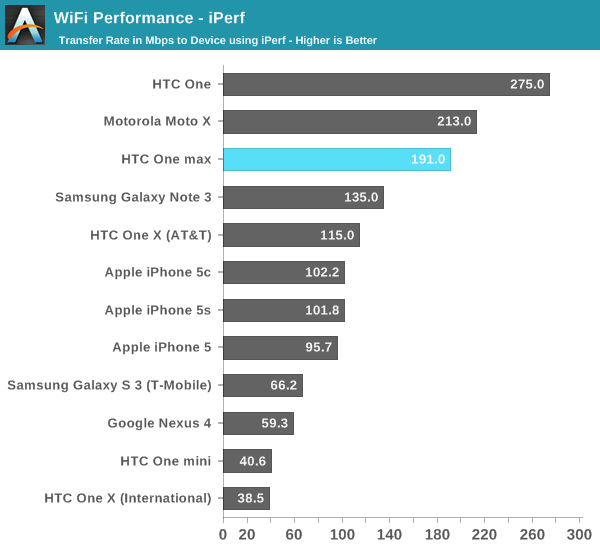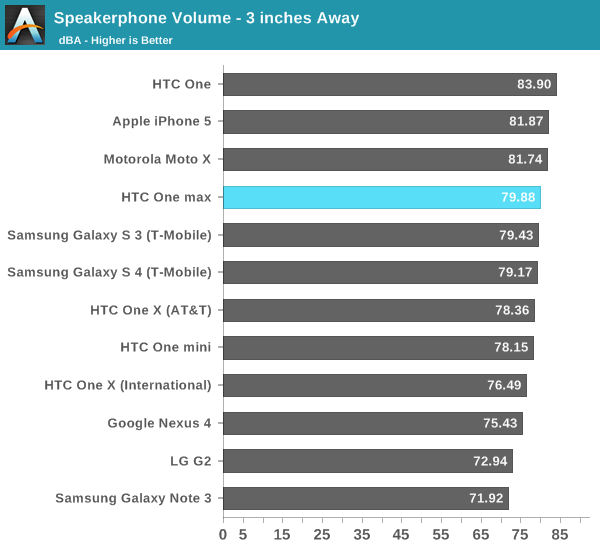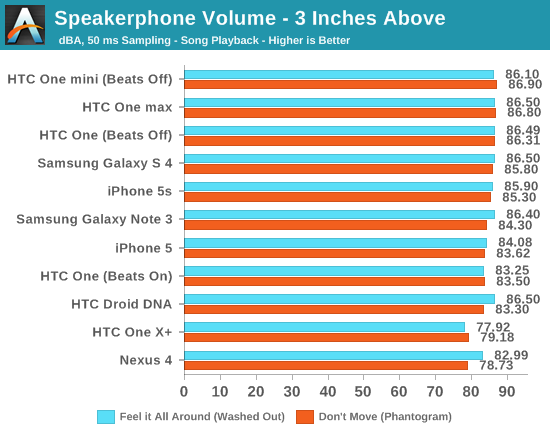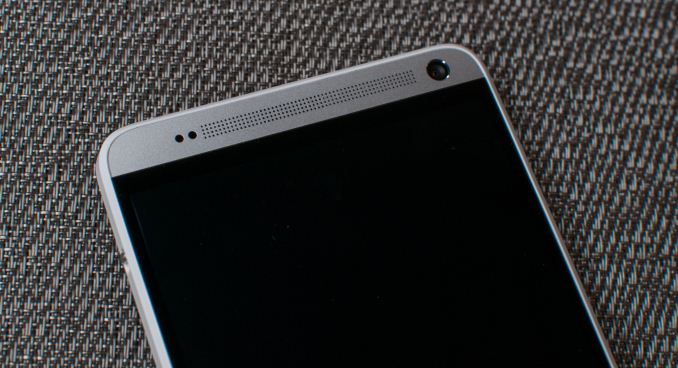HTC One max Review - It's Huge
by Brian Klug on October 28, 2013 10:00 AM EST- Posted in
- Smartphones
- HTC
- Mobile
- One
- Snapdragon 600
- Android 4.3
- One max
Cellular
Cellular on the One max is pretty much the same story as the One, and another shared bullet point. The top and bottom metal cutouts are still the radiative surfaces of the antenna, and there’s still transmit and receive diversity as well to mitigate any unwarranted antenna detuning from holding the device. The unit I was sampled has LTE banding for EMEA (Europe, Middle East, and Africa), but there’s appropriate banding for Asia, Sprint (a tri-mode device with 800/1900 MHz and TDD-LTE on 2600 MHz) and Verizon (700 MHz and AWS), according to the HTC specs page.
The baseband inside the One max is again shared with the One (Qualcomm’s 2nd generation multimode LTE MDM9x15 family), although the One max does have a bit more band support for the USA LTE on Sprint and Verizon, so the front ends are different.
WiFi
Interestingly enough with the One max we see HTC going to Qualcomm Atheros for the WLAN and BT combo, best I can tell this is the WCN3680 which is probably a bit cheaper to include than the BCM4335 we saw in the One. It’s still a single spatial stream 802.11ac capable part, meaning a PHY rate of up to 433 Mbps if you’re in the right channel conditions with 80 MHz channels on 5 GHz. The WCN3680 combo is the 802.11ac successor to WCN3660 which we saw in a number of phones last generation, and is accelerated by the SoC. WCN3680 also does BT 4.0, and FM Rx/Tx if applicable.

To test throughput on the One max I used iPerf the same way I have for a while now. Subjectively there are no complaints from me about WLAN connectivity on the One max, no random dropouts or issues, and Sense 5.5 thankfully still includes the WiFi frequency band manual selection option.
I saw the WCN3680 solution inside Moto X already, it’s interesting to see it in the One max. I believe the One mini uses its 802.11n cousin, WCN3660 as well, probably again for cost reasons.
Speakerphone
Although Beats is gone since that partnership has ended as of the One max, the device still seems to retain everything that made it sound great. There are still the larger-than-typical speaker chambers, big speaker grilles on the top and bottom, stereo sound, and importantly the TFA9887 speaker amplifier and protection part from NXP. In addition there’s still the TPA6185 headphone amplifier as well.
Beats always seemed to be an audio compressor that ran on the DSP, ostensibly through the Hexagon DSP access program or something, and that’s what’s absent on the One max. There’s no toggle under settings for enabling or disabling it, nor the Beats branding, but to be honest I almost always disabled Beats on the One anyways since it was a fair amount louder with it disabled. What made the One great was all the hardware behind the speakers, not so much the software compressor.


The One max goes plenty loud just like the original One. I went ahead and added the One mini and 5s to the chart too, just to check whether things have changed much, in addition to the Galaxy S 4 and Note 3. The One max basically performs like the One with Beats turned off, which isn’t a surprise since it isn’t there anymore. There’s also no detectable saturation, and the One line remains the only device that doesn’t sound tinny or rattly with overemphasized highs and lacking mids. I suspect the A weighting I selected a while ago for measuring might be a contributing factor as well. Either way you’re not going to be wanting for more loudness on the One max, and the inclusion of front firing stereo speakers makes for a completely different listening experience.












197 Comments
View All Comments
GruntboyX - Monday, October 28, 2013 - link
I love how the dimensions are reported in mm. However the screen size is in inches.MercuryStar - Tuesday, October 29, 2013 - link
As an Australian, this is absolutely normal here - we use mm for dimensions of all things except for diagonal screen size which is pretty much always quoted in inches - for everything from laptops to TVs to smartphones.nerd1 - Monday, October 28, 2013 - link
I always liked Brian's review for the most part for this time it's getting ridiculous.iPhone 5GS 64GB: $399 w/contract
Galaxy 4S 80GB (16GB+64GB sdXC): $199 w/ contract
Isn't it obvious to see the advantage? If you always have a bunch of 64GB devices around to review (and unlimited LTE) for free you may not know but to us mortals the saving of $200 far exceeds any inconveniences (if all) of managing them.
It's like arguing having only a single SSD storage for laptop is better than SSD+HDD hybrid because the former is faster, lighter and more failproof. Problem is not everyone can purchase 1TB of PCIe SSD, and some people prefer 128 SSD + 1TB HDD setup at a fraction of the cost.
MercuryStar - Tuesday, October 29, 2013 - link
I don't think the author is claiming that SD cards slots are bad, just that very few people use them, or would use the added capacity they would provide, thus making them a lower relative priority compared to other things like, in the case of this phone, added thickness and weight of the removable back.Someone else was saying in another comment that carriers who bundled phones with a free SD card in the box found that the majority of people still didn't use the SD card.
chizow - Tuesday, October 29, 2013 - link
I guess it never occurred to them that the bundled SD card is basically useless due to it's capacity and not it's utility? I don't use them either but with 2GB storage I can't even use to load a Windows ISO. I leave them in the box too, but replace them with my own 32 or 64GB card.....chizow - Tuesday, October 29, 2013 - link
Exactly, it's like all the reviewers out there getting free 128GB iPads to review and totally understanding Apple's position about not including a microSD slot. Yet they don't realize, most people don't want to pay $800-$900 for 128GB of storage and Cellular over the base $500 model....Mr Majestyk - Monday, October 28, 2013 - link
Why is the Sony Z Ultra missing, much more compelling device to me than One Max? Also why use 4 decimal places on the max brightness? Really, we don't even need a single decimal place for this measure, just round it to nearest integer. Human eye can't tell minute changes in brightness at the bright end, like it can at the dark end.piroroadkill - Tuesday, October 29, 2013 - link
Sony are killing it at the moment, in my opinion.By FAR the best mid-range handset for the money is the Xperia SP. At the high end you have the Xperia Z1, then for people who have gorilla hands, the Z Ultra.
All better phones than their counterparts by other manufacturers like HTC or Samsung. Yet, where are the reviews?
synaesthetic - Monday, October 28, 2013 - link
The amount of logical fallacies being committed in this comments section is staggering.Personally I'd prefer sdcard slots in my phones, but the reality is most people don't care or don't know or aren't familiar with their use. They're going away, slowly but surely. Samsung and Sony are really the only holdouts, with the exception of bargain-basement budget devices that cut internal eMMC down to 4GB or smaller to keep BOM cost as low as possible.
Those of us who want our phones to be purely functional powerhouses of mobile computing are sadly in the minority, and the market is absolutely a tyranny of the majority.
bairlangga - Monday, October 28, 2013 - link
Agree. Just snapped a 64gb sdxc uhs1 on my xperia yesterday. Couldn't be much happier ;-)